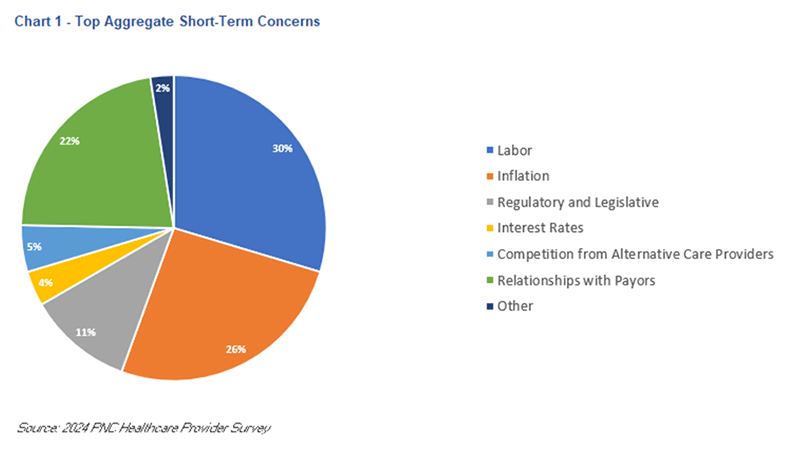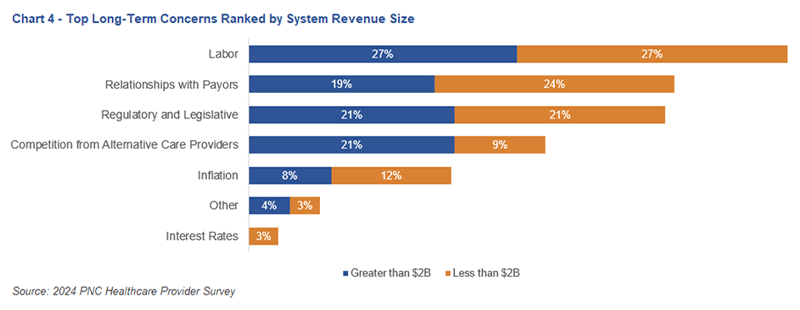
As healthcare systems continue to stabilize following the COVID-19 pandemic, they face a myriad of challenges. While volumes have largely returned to pre-pandemic levels, operations are still threatened by labor shortages, high costs, strained payor relationships, and evolving regulatory and legislative scrutiny. At the same time, the healthcare landscape as we know it has begun to shift with disruptive new entrants, an aging population, and industrywide consolidation.
Building on the results of our inaugural survey, the 2024 PNC Healthcare Provider Survey provides further insight into which challenges are most concerning to hospitals and health systems across the U.S. as the industry evolves.
The participating hospitals and health systems were asked to rank their top three Short-Term (12-24 months) and Long-Term (2-5+ years) concerns from a list that included:
- Labor Shortages and Competition for Labor
- Inflationary Pressures
- Competition from Alternative Care Providers
- Relationships with Payors
- Elevated Interest Rates
- Regulatory and Legislative Environment
The Results
Top three short-term concerns:
- Labor Shortages and Competition for Labor (30%)
- Inflationary Pressures (26%)
- Relationships with Payors (22%)

View accessible version of this chart.
Top three long-term concerns:
- Labor Shortages and Competition for Labor (27%)
- Regulatory and Legislative Environment (21%)
- Competition from Alternative Care Providers (21%)

View accessible version of this chart.
Notably, labor was cited as both the number one short-term and long-term concern for the second year in a row, indicative of the industry’s continued struggle with the tight labor market. Inflation was also the number two short-term concern for a second consecutive year, but it ranked lower on the list of long-term concerns. Most respondents indicated that they were continuing to grapple with rising costs in the near-term but expected that issue to subside over the next several years.
Of the providers surveyed, 59% represent health systems with greater than $2 billion in revenue, while the remaining 41% are below this threshold. Although respondents’ near-term concerns were largely consistent regardless of size, there was more disparity on long-term issues. Larger systems were more likely to be concerned about competition from alternative care providers, while smaller systems tended to rank relationships with payors and inflation higher on their lists.

View accessible version of this chart.

View accessible version of this chart.
Key Takeaways
Outside of the top concerns identified, there were five key themes that emerged from our discussions on the landscape of healthcare heading into 2024 and beyond:
- Hospitals have shifted away from crisis management.
Providers are still dealing with many pressing near-term challenges, but they have mostly moved away from putting out fires. Large systems especially were focused on strategic planning and positioning their organization for success in a changing industry. Many respondents were planning capital projects and receptive to M&A opportunities.
- Labor is still top of mind.
Most hospitals’ use of contract labor has declined, and the cost of contract labor has largely gone down from the COVID-19 peak. However, labor issues persist, and hospitals are taking steps to attract and retain talent. On the recruitment side, respondents indicated use of near-term strategies including sign on bonuses, shorter time-to-offer, employee referral programs, in-house staffing agencies, labor float pools, and international recruitment. On the retention side, respondents emphasized the importance of corporate culture, flexible work arrangements, virtual nursing models, clear career paths, and benefits like tuition reimbursement in addition to higher wages. Longer-term, respondents expect to benefit from partnerships with schools aimed at growing the healthcare workforce. Respondents also had high hopes for the potential of AI on administrative workflows such as revenue cycle management, but few were currently using the technology.
- Payor relationships are strained and becoming increasingly harder to manage.
Payors generated record profits early in the pandemic, but they have since been negatively impacted by care backlogs. Survey respondents reported experiencing changes in payor behaviors post-pandemic including increased claim denials, challenges with pre-authorization, and long and costly contract negotiations that sometimes result in going out of network. Although healthcare systems have consolidated in recent years, the largest payors are still roughly ten times the size of the largest health systems, creating a negotiating imbalance that many respondents described as untenable in the long-term. Larger systems in areas with strong demographics tended to fare better in payor negotiations and had a more neutral outlook.
- Providers are under pressure to make healthcare more affordable.
Against the backdrop of an election year, many respondents were concerned about the long-term budgetary implications of regulatory and legislative issues. As the Baby Boomers (the largest tax base in US history1) age, government healthcare program costs are skyrocketing while tax revenues decline. Since healthcare spending makes up an outsized and growing share of GDP (17.3% in 2022 according to CMS2), policymakers will naturally look to the sector as a major opportunity to close the gap with budget cuts. It would take industrywide transformation to fix the growing structural imbalance between revenues and costs to make healthcare more affordable. Some providers were skeptical about the feasibility of industry transformation, noting that previous initiatives have historically only made the cost of care increase.
- The healthcare industry is changing.
Healthcare systems across the country are consolidating while new entrants like Amazon, CVS, Walgreens and Optum seek to disrupt the industry, changing the competitive landscape. Although most respondents did not consider private equity and alternative care providers entering the healthcare space to be a serious near-term threat, health systems are paying attention to what industry disruptors are doing. Primary care is not profitable for health systems, and respondents noted that they were not threatened by alternative care providers entering the primary care space if they can maintain a strong referral network. Providers were more concerned about more profitable service lines like surgery, oncology, and imaging being disrupted by these players, as it could end up making hospital care incredibly expensive in the future.
While some of the challenges facing the industry are not new, the sense of urgency to address them has become more prevalent. As providers continue to look for solutions to address these challenges, technological advancement like AI and other innovative solutions will likely play an important role in solving these longstanding problems.
Once again, we would like to thank all the organizations who participated in the 2024 PNC Healthcare Provider Survey. We appreciate your time, valued insights, and continued partnership.
Sources
Accessible Version of Charts
Chart 1: Top Aggregate Short-Term Concerns
| ST Concerns | All Healthcare Providers |
| Labor | 30% |
| Inflation | 26% |
| Regulatory and Legislative | 11% |
| Interest Rates | 4% |
| Competition from Alternative Care Providers | 5% |
| Relationships with Payors | 22% |
| Other | 2% |
Source: 2024 PNC Healthcare Powder Survey
Chart 2: Top Aggregate Long-Term Concerns
| LT Concerns | All Healthcare Providers |
| Labor | 27% |
| Inflation | 10% |
| Regulatory and Legislative | 21% |
| Interest Rates | 1% |
| Competition from Alternative Care Providers | 16% |
| Relationships with Payors | 21% |
| Other | 4% |
Source: 2024 PNC Healthcare Powder Survey
Chart 3: Top Short-Term Concerns Ranked by System Revenue Size
| Short-Term Concerns (aggr) | Greater than $2B | Less than $2B |
| % of Aggr 1 | % of Aggr 2 | |
| Other | 2% | 3% |
| Interest Rates | 4% | 3% |
| Competition from Alternative Care Providers | 6% | 3% |
| Regulatory and Legislative | 10% | 12% |
| Relationships with Payors | 21% | 24% |
| Inflation | 27% | 24% |
| Labor | 29% | 30% |
Source: 2024 PNC Healthcare Powder Survey
Chart 4: Top Long-Term Concerns Ranked by System Revenue Size
| Long-Term Concerns (aggr) | Greater than $2B | Less than $2B |
| % of Aggr 1 | % of Aggr 2 | |
| Interest Rates | 0% | 3% |
| Other | 4% | 3% |
| Inflation | 8% | 12% |
| Competition from Alternative Care Providers | 21% | 9% |
| Regulatory and Legislative | 21% | 21% |
| Relationships with Payors | 19% | 24% |
| Labor | 27% | 27% |
Source: 2024 PNC Healthcare Powder Survey




